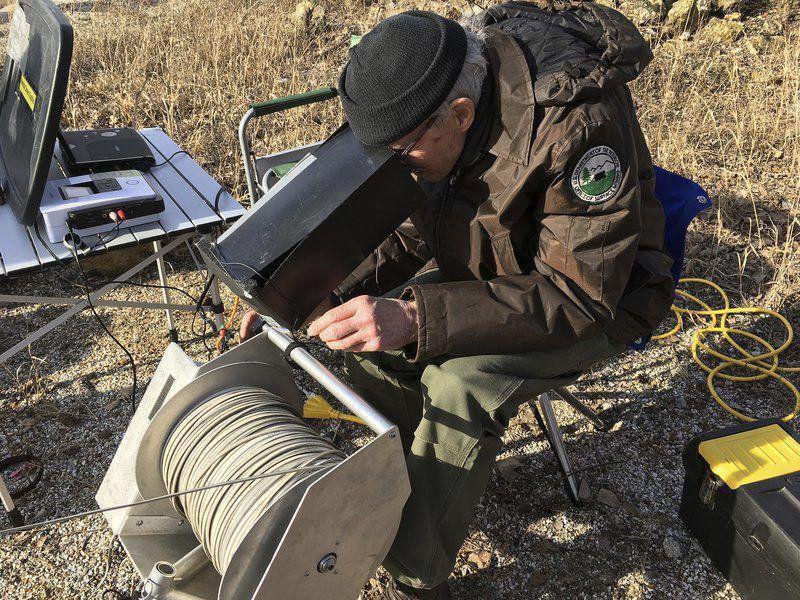Oklahoma: Experts Assist Cold-Case Investigators With Camera Drops Into Mine Shafts

By Jeff Lehr
January 13, 2020 - A team from the Office of Surface Mining, Reclamation and Enforcement lent its expertise recently to the search for the remains of Lauria Bible and Ashley Freeman in Oklahoma.
The four experts with the federal agency’s regional office in Alton, Ill., were briefed last week by state and local authorities involved in the investigation of the presumed slayings of the two 16-year-old girls 20 years ago and the continuing efforts to locate their remains in the Picher Mining Field.

Brian Hicks, with the Office of Surface Mining, Reclamation and Enforcement office in Alton, Ill., operates a borehole camera at a site near Picher.
Photo provided
Their expertise in the areas of mining, hydrology, soil composition and the operation of a submersible borehole camera they brought with them was sought by cold-case investigators and obtained with the assistance of U.S. Sen. Jim Inhofe, R-Okla. After a briefing, the team toured three of four mine shafts in the Picher area that investigators think could be the most likely locations where the girls’ abductors may have disposed of their bodies.
“We want to stress again that we don’t have good, solid information that they’re even in a mine shaft,” Gary Stansill, an investigator with the Craig County district attorney’s office, told the Joplin (Mo.) Globe.
But that’s the purported fate of the two teens that comes up the most often in tips received by investigators, he said.
An analysis made by Jim Martell, an engineer with the Army Corps of Engineers in Tulsa, and Ed Keheley, a retired nuclear engineer and leading expert on the history of the Picher Mining Field, identified two of the four mine shafts that investigators remain most interested in searching. The other two were developed as a result of tips received by cold-case investigators Stansill and Tammy Ferrari, a special agent of Oklahoma State Bureau of Investigation.
The experts from the federal agency, which is a branch of the U.S. Department of the Interior, took to the field, conducting another camera drop at the old Acme Mine shaft 42 on the south side of Picher. State and local authorities conducted two camera drops there in November but wished to take advantage of the better camera the federal experts brought with them to take another look at the shaft and get their input on the feasibility of any future search of the mine workings at its bottom.
Mine shaft 42 drew the interest of investigators when a man came forward in September to report he recognized media photos of two of the three suspects in the Freeman-Bible slayings as two of the three men he saw inside a vehicle in the general vicinity of that mine shaft shortly after the December 1999 killings of the Freeman girl’s parents and the disappearance of the two teens.
He identified the men he recognized as deceased suspects Warren “Phil” Welch and David A. Pennington. The third suspect, Ronald D. Busick, 68, who was charged in April 2018 with the slayings, kidnappings and torching of the Freeman family’s home, was found competent to stand trial by a jury in December but has not as yet provided investigators with any solid information on where the girls’ remains may be.
Stansill said the borehole camera is a more sophisticated piece of equipment than the cameras used previously by investigators and the Tulsa Police Department dive team. He said it has a lens that can be maneuvered vertically, horizontally and around in a circle, giving a much better look at the makeup of the walls of the shaft and any debris or objects it may come across.
Stansill said the water in Acme Mine shaft 42 was murkier Wednesday than had been the case in November and hindered the views the camera was able to obtain of the shaft’s walls and depths. But they were able to determine that there is a significant amount of debris blocking access to the bottoms and the mine workings where the remains of any bodies discarded there could have been carried by water over time.
He said a determination will have to be made based on the data the team was able to retrieve as to whether the debris in the shaft can be brought to the surface and sifted as a preliminary to a search of the workings in some manner once the debris is removed. A search via a remote-operated vehicle equipped with a camera remains a possibility.
A certain amount of risk is inherent in any search of the mine shafts in the Picher area because of their age and condition, according to Christopher Holmes, a spokesman for the Office of Surface Mining, Reclamation and Enforcement team. But conditions were better in the second shaft the group began searching about midafternoon, Holmes said.
Investigators were keeping the exact location of that shaft under wraps for investigative reasons. But Homes characterized the data obtained there with the use of the borehole camera as “very good.” He said they were able to get a “clear look” at that shaft.
Holmes said the team’s goals were to assess the conditions of the shaft with regard to the feasibility of future searches and to try to determine how best to approach and retrieve anything of interest that a camera might detect.
One of the four shafts is part of the old Admiralty Mine holdings and lies north of an Admiralty Mine shaft searched in connection with the case in January 2000, just days after the disappearance of the girls.
Holmes said the team’s ultimate goal is to help provide some closure to the families of the two girls. He said it remains to be seen what the agency’s role may be in future efforts to achieve that.
“We are working closely with both the state and local law enforcement officials to try to bring a successful conclusion to this,” he said.

